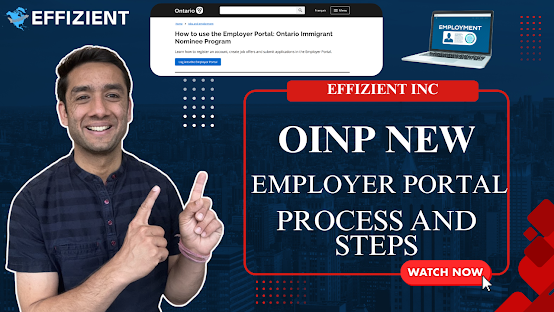International Students in Canada need to spend more now| How to ensure that your Closed WP is not refused| New OINP Portal - All that you need to know| OINP Employer portal explained |2025 Canada Immigration News
IRCC Raises Cost-of-Living Requirements for International Students – Effective Sept 1, 2025
Canada’s Immigration, Refugees and Citizenship Canada (IRCC) will increase the minimum cost-of-living funds international students must show when applying for study permits starting September 1, 2025. Applicants (outside Quebec) must now demonstrate CAN $22,895, a hike from $20,635, with proportional increases for family-based applications (e.g., two members need $28,502, three require $35,040).
The new level reflects an annual adjustment tied to the country’s rising cost of living. It applies to all study permits submitted on or after the effective date; current applications remain under the old threshold. Permitted proof of funds includes Canadian bank accounts, Guaranteed Investment Certificates (GICs), education loans, bank statements, drafts, sponsorship letters, and scholarships.
This change is designed to ensure students can comfortably support living expenses—beyond tuition and travel—while in Canada. Prospective applicants with family members should plan for the adjusted amounts to accurately demonstrate financial readiness for studies in Canada.
How to ensure closed work permit is not refused
Avoid common pitfalls in your Canadian closed work permit application by clearly demonstrating your ability to fulfill job requirements. The video emphasizes understanding the NOC (National Occupational Classification) code for your specific job, which outlines essential education and work experience.
Ensure your application reflects the minimum education and years of experience specified in the NOC description, supported by reference letters. If your profession requires certifications or provincial licensing, ensure these are met, especially if mandatory in your target province.
Finally, crucial for all applications is language proficiency in English or French. While not in the NOC, demonstrating fluency through accepted tests like IELTS or CELPIP, aiming for a CLB level 7, significantly strengthens your application, particularly for skilled positions.
Click here to watch the full video on YouTube and learn how this information may affect your Canadian immigration journey.
Ontario’s OINP Gains New Power to Return Applications from July 1, 2025
As of July 1, 2025, the Ontario Immigrant Nominee Program (OINP) now has the authority to return applications before issuing a provincial nomination under the Working for Workers Seven Act. Applicants (or their representatives) will be notified and refunded the full application fee if their submission is returned.
Ontario’s Ministry of Labour, Immigration, Training and Skills Development also introduced several other major changes: mandatory in-person interviews for employers and applicants (with accommodations available); reduced education requirements for early childhood educators applying through select streams if they’re members of the College of Early Childhood Educators; and the launch of an Employer Portal to support employer-led applications.
These reforms enable the province to better align applications with labour-market priorities, enhance program integrity, and streamline employer job offer streams. With a halved provincial nomination allocation, Ontario is placing a greater emphasis on high-quality, labour-market aligned candidates, returning those that don’t meet current economic needs.
OINP Employer Portal - Process and steps to follow - Watch the Video NOW!
📢 Ontario Immigrant Nominee Program (OINP) has launched a new Employer Portal, and our RCIC has prepared a detailed YouTube video explaining everything you need to know!
If you're an employer looking to support foreign workers through the OINP or a candidate wanting to understand how this new system impacts your application, this video breaks down the entire process and key steps involved in using the new portal. From registration to submitting a job offer, we cover it all in a clear and simplified manner.
Whether you're navigating the system for the first time or adapting to the updated process, this guide will help you stay on track and avoid costly errors.
🎯 Don’t miss out on these important insights—click the link below and watch the video now to stay updated and make the most of the OINP Employer Portal changes!
2025 Mid-Year Immigration Review: Canada’s Major Policy Overhaul
Canada’s mid-year immigration review highlights sweeping changes introduced by IRCC in 2025. The 2025–2027 Levels Plan reduces permanent resident targets while, for the first time, introducing temporary resident quotas with clear goals for workers and francophones. Provincial Nominee Programs saw a 50% cut in federal allocations, prompting provinces like Newfoundland and Labrador to adjust stream rules, pause certain intakes, and adopt expression-of-interest systems.
Two new permanent residence pathways—the Rural Community Immigration Pilot and the Francophone Community Immigration Pilot—launched on January 30, targeting regional and linguistic disparities; both worker-in-Canada streams hit capacity on day one. Meanwhile, Canada’s temporary resident population growth slowed, rising from 2.7 million in early 2024 to 3.02 million by January 1, 2025, prompting targets to reduce temporary residents from 7.4% to 5% of the population by end-2026.
Additional updates include a study-permit exemption for construction apprentices and Quebec’s suspension of several worker streams, with plans to scale back temporary foreign worker numbers and set provincial admission targets.





Comments
Post a Comment